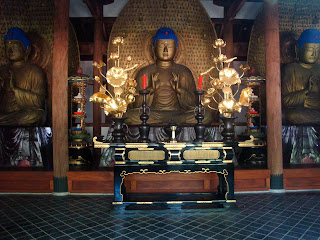Temples dedicated to Amida use gold to make a strong impression of light
- Light is a basic metaphor of Buddhism--the whole thing is to find en-LIGHT-enment, right? To stimulate people to think a bit about enlightenment, some temples offer a darkness experience, which can give you a refreshed view of light. The temple Zenkoji in Nagano City has a famous darkness experience. Inside the main hall of the temple, there is a staircase going down into a completely dark hallway. At the bottom of the stairs, you put your right hand against the wall and proceed, unseeing, into the darkness. After going around a corner or two, your hand will encounter a traditional Japanese lock holding something closed. This means that you are directly under the statue of Amida Buddha (a Buddha of light) in the main altar. You can rattle this lock and pull on it as a sign of your desire to go to the Pure Land of Amida. The darkness symbolizes ignorance and death, while the Pure Land is a kind of heaven which you can reach after death by believing in Amida. So this act is a kind of rehearsal or simulation of death. But you are really still alive, so you can proceed onward, finally reaching another stairway up to the main hall. Near the top of the stairway is a large mirror, allowing you to see your 'reborn' self for the first time.
The main hall of Zenkoji
 |
| Temple stamps can be obtained when making a donation. This one shows Amida. |
The Pure Land school of Buddhism is widespread in Japan, although Zenkoji was founded without affiliation to any particular sect. Nowadays, ceremonies are conducted by priests of both Pure Land and Tendai traditions. The Amida statue at Zenkoji is a 'hibutsu,' or secret Buddha, that is never exposed to view. There is no explicit reason for this, but one can imagine it is to stimulate the desire to meet Amida.
 |
| Gyokushin Mitsuin |
Near the southwestern edge of Tokyo is the temple Gyokushin Mitsuin, commonly known as Tamagawa Daishi. The Daishi, or Great Master, in this case, is Kobo Daishi, who studied Vajrayana Buddhism in China and established Shingon Vajrayana Buddhism in Japan. This temple seems rather unassuming--the roofline is not especially high, and the grounds are not spacious. There is a small garden with several stone Buddhas and several gongs and bells that can be rung, using the sense of hearing as a drive to enlightenment.
 |
| Kongosho, a ritual implement |
You can enter the main hall to approach the altar of Kobo Daishi. The priest is very likely to offer greetings and a short chat (in Japanese) if you are interested. Here there is also a stairway down to a world of darkness. The priest recommends repeating 'Namu Daishi Henjo Kongo' as you descend into the darkness. Again, you use your right hand on the wall as you proceed. Soon, you will find a kongosho or vajra ritual implement in a niche in the wall. You can hold onto it, visualizing its power of protection. As you continue, the path curves around, while there are also upward and downward slopes. Finally, you emerge into the brightly illuminated Henjo Kongo Den, a cave-like temple with hundreds of stone Buddhas of various sizes. Among them, Dainichi Nyorai (the Cosmic Buddha, also a Buddha of light) and Kobo Daishi are prominent. There are also 88 statues that allow you to replicate the pilgrimage to 88 temples of Shikoku Island. Another suggestion of the priest is to find the number among the 88 that corresponds to your age, and make a wish (I guess if you are 89 or older, you start again from no. 1). There are statues of Avalokitesvara/Kuan Yin and many other Buddhas. There are twelve Buddhas that correspond to the 12 animals of the Chinese zodiac, allowing you to find your personal Buddha based on your birth year. Finally, as you leave, there is a large gong which you can ring to announce the successful completion of your mini-pilgrimage. I bought a nice representation of a kongosho that you can attach to a phone or handbag as a reminder of the pilgrimage, and a copy of the Heart Sutra that is small enough to be used in the same way.
Amida Buddha



very mice blog Enlightenment Japan
ReplyDelete